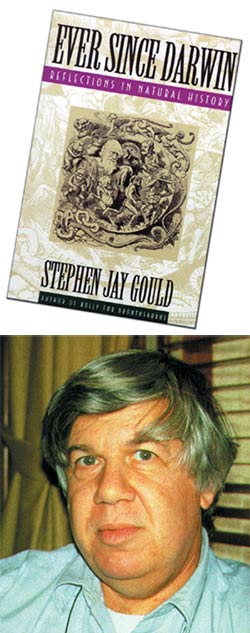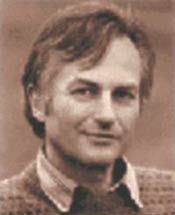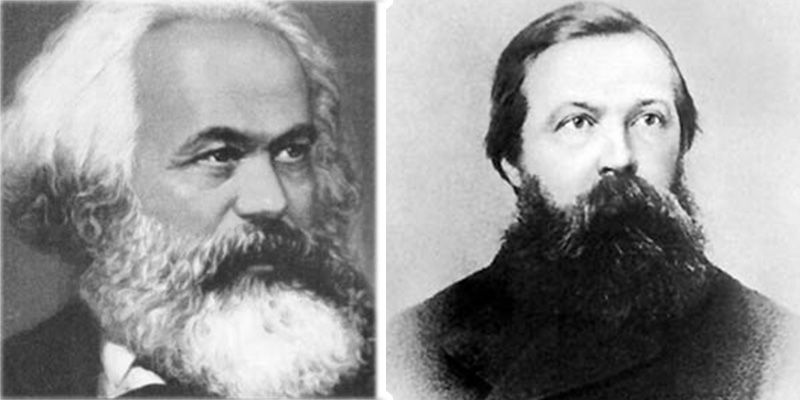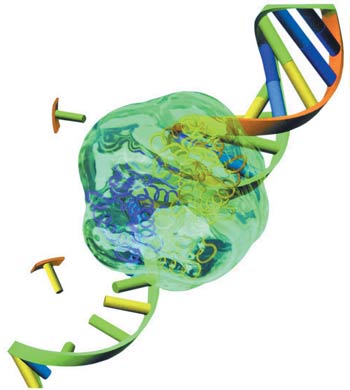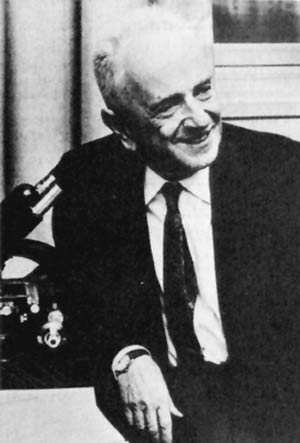Bigotry: The Dark Danger
The Evolution Impasse 1

DOWNLOAD THE BOOK
CHAPTERS OF THE BOOK
< <
5 / total: 11
DDarwin, Charles RobertThe first person to propose the theory of evolution in the form it’s accepted today was Charles Robert Darwin, an amateur British naturalist. Darwin never received any genuine training in biology and possessed only an amateur knowledge of nature and living things. As a result of his interest he took his place as a volunteer on the discovery vessel HMS Beagle, which sailed from Britain in 1832 and traveled through various regions of the world over the next five years. Darwin was highly influenced by the different species he saw during the course of this voyage, and especially by the different species of finches he observed on the Galapagos Islands. He concluded that the differences in these birds’ beaks stemmed from their adaptation to their surroundings. As a consequence of this idea, he assumed that the concept of environmental adaptation lay at the heart of all the variety among living things.
Yet in making that assumption, Darwin ignored the scientific facts, opposed the evidence that God created all living species, and suggested that living things were all descended from some common ancestor and became differentiated from another due over time, due to environmental conditions. This hypothesis of Darwin’s was based on no scientific facts or experiments. However, with the support and encouragement that he received from eminent materialist biologists of the time, Darwin gradually worked up these hypotheses into a coherent theory, according to which all living things were descended from a single primitive ancestor, but had been subjected to minute changes over very lengthy periods of time, and thus diverged anatomically from one another. The ones that best adapted to their surroundings passed their characteristics on to subsequent generations, and these beneficial changes thus accumulated in such a way as to turn these individuals’ offspring into life forms that were very different from their forerunner. (How these beneficial changes came about unclear, however.) According to Darwin, human beings were the most advanced product of this hypothetical mechanism. Darwin called this product of his own imagination “evolution by way of natural selection.” He now imagined that he had discovered the origin of species. The origin of any one species was another, less developed species. He eventually announced these ideas in his book The Origin of Species, published in 1859. Darwin constructed his theory on the concept of natural selection, which meant the survival of the strongest individuals or those best able to adapt to environmental conditions in the struggle for survival in their environment. That is the claim emphasized in the subtitle of Darwin’s book: The Origin of Species: By Means of Natural Selection. Darwin’s groundless logic followed this reasoning: There are natural and random differences within any living species. Some cattle are larger than others, for example, and others are darker in color. Those characteristics that are most advantageous will be favored through natural selection, and the beneficial characteristic in question will thus come to predominate in that animal population. Through an accumulation of these features over a long period of time, a new species will emerge. However, this theory of evolution by way of natural selection, as by Darwin proposed it, left unanswered the most fundamental questions right from the outset. If living things had evolved in stages, as Darwin claimed, then a great many transitional forms must have existed as well. Yet the fossil record revealed no trace of these theoretical transitional life forms. Darwin puzzled over this problem for a long time and eventually had to conclude that hopefully, such fossils would be unearthed in the future. Despite the passage of the intervening 150 years, however, the expected fossils have still not been found. Darwin was in an equally hopeless position when it came to accounting for such complex organs as the eye, ear and wing in terms of natural selection. It was impossible to maintain that these organs developed in stages, since the absence of even a single component would render them totally functionless,. (See Irreducible Complexity.) Indeed, Darwin was forced to state the difficulties he experienced regarding his theory in his book. (See Origin of Species, the) Before all, the question of how the organism that by Darwin referred to as the ancestor of all living things came into being remained a complete mystery—because it is impossible for inanimate matter to come alive by means of natural processes. Eventually, advances in science and technology were to fundamentally undermine his theory, which was the product of Darwin’s primitive knowledge of science. DarwinismSee Evolution Theory, the. Darwinism and Racism
Most present-day Darwinists claim that Charles Darwin was not actually a racist, but that racists have interpreted his ideas in a biased manner in order to support their own views. They maintain that the expression “by means of The Preservation of Favored Races” in the subtitle of his book The Origin of Species is meant solely for animals. However, those who make such claims ignore what Darwin actually said about human races in his book The Descent of Man. According to the views that by Darwin set out in that book, the different human races represented different stages of evolution, and some races were more highly “evolved” and thus advanced than others. Some, in fact, were pretty much at the same level as apes. Darwin suggested that the struggle for survival also applied to human races, (See Struggle for Survival, the.) In the course of that struggle, favored races would be victorious. According to Darwin, these favored were European whites. Asians and Africans, on the other hand, had lagged behind in the fight for survival going on in the world. Darwin went even further and suggested that these races would soon lose the struggle entirely and be eliminated altogether: At some future period, not very distant as measured by centuries, the civilised races of man will almost certainly exterminate, and replace the savage races throughout the world. At the same time the anthropomorphous apes. . . will no doubt be exterminated. The break between man and his nearest allies will then be wider, for it will intervene between man in a more civilised state, as we may hope, even than the Caucasian, and some ape as low as a baboon, instead of as now between the negro or Australian and the gorilla. 109 In another chapter of The Descent of Man, Darwin claimed that inferior races should disappear, and that there was no need for advanced human beings to protect them and seek to keep them alive. He compared this situation to livestock breeders: With savages, the weak in body or mind are soon eliminated; and those that survive commonly exhibit a vigorous state of health. We civilised men, on the other hand, do our utmost to check the process of elimination; we build asylums for the imbecile, the maimed, and the sick; we institute poor-laws; and our medical men exert their utmost skill to save the life of every one to the last moment. . . .Thus the weak members of civilised societies propagate their kind. No one who has attended to the breeding of domestic animals will doubt that this must be highly injurious to the race of man. 110
In line with these statements, Darwin regarded native Australians and blacks as being at the same level as gorillas and maintained that these races would eventually become extinct. He also advocated the need to prevent other races whom he regarded as inferior from multiplying. and that these races should therefore be eradicated. Darwin thus approved of and justified racist and discriminatory practices, the remains of which can still be seen today. According to Darwin’s racist ideas, the duty of any civilized human being was to speed up this evolutionary process. That meant that there was no scientific reason why these backward races should not be eliminated right away! Darwin’s racist side revealed itself in several of his writings and analyses. For example, in 1871, in describing the native people of Tierra del Fuego that he had seen during the course of his long voyage on the Beagle, he made his racist preconceptions perfectly clear. He depicted them as "wholly nude, submerged in dyes, eating what they find just like wild animals, uncontrolled, cruel to everybody out of their tribe, taking pleasure in torturing their enemies, offering bloody sacrifices, killing their children, ill-treating their wives, full of awkward superstitions. 111 Yet the researcher W. P. Snow, who had visited the same region ten years earlier, described those same people as; … powerful looking, strong, fond of their children, having inventive handicrafts, bearing the notion of private ownership for some goods and accepting the authority of the elder women in the community. 112 From these examples, it is clear that Darwin was a full-fledged racist. Indeed, as Benjamin Farrington, author of the book What Darwin Really Said, puts it, Darwin made many comments about “the evident nature of the inequality among human races” in The Descent of Man. 113
Moreover, Darwin’s theory denied the existence of God, leading to his ignoring fact that man is an entity created by God and that all human beings are created equal. This was another factor that accelerated the rise of racism and its worldwide acceptance. The American scientist James Ferguson states that there is a direct relation between the rejection of creation and the rise of racism: The new anthropology soon became a theoretical background between two opposed schools of thought on the origin of humans. The older and more established of these was 'monogenism,' the belief that all humankind, irrespective of colour and other characteristics, was directly descended from Adam and from the single and original act of God's creation. . . . [In the 18th century] opposition to theological authority began to fuel the rival theory of 'polygenism,' (theory of evolution) which held that different racial communities had different origins. 114 The Indian anthropologist Lalita Vidyarthi describes how Darwin’s theory of evolution imposed racism on the social sciences: His (Darwin’s) theory of the survival of the fittest was warmly welcomed by the social scientists of the day, and they believed humanity had achieved various levels of evolution culminating in the white man’s civilization. By the second half of the nineteenth century, racism was accepted as fact by the vast majority of Western scientists. 115 Many Darwinists after Darwin set about trying to prove his racist opinions. For that purpose, they had no qualms about perpetrating scientific distortions and fraud. They imagined that if they managed to prove their own superiority, they would also have scientifically demonstrated their own superiority and their right to oppress, exploit, and if necessary, even eradicate other races. Stephen Jay Gould also stated that some anthropologists twisted the facts in order to demonstrate the superiority of the white race. According to Gould they most frequently resorted to engaging in distortions regarding the brain sizes of skulls they discovered. In one book Gould describes how many anthropologists suggested there was a direct relation between brain volume and intelligence and how, despite having no true criteria, they exaggerated the brain volumes of Caucasians in particular and portrayed these as greater than those of blacks and Native Americans. 116 Gould sets out some of the unbelievable claims that Darwinists made to depict certain races as inferior: Haeckel and his colleagues also invoked recapitulation [the theory of the repetition of the so-called evolutionary process during individual growth] to affirm the racial superiority of northern European whites. They scoured the evidence of human anatomy and behaviour, using everything they could find from brains to belly buttons. Herbert Spencer wrote that “the intellectual traits of the uncivilized are traits recurring in the children of the civilized.” Carl Vogt said it more strongly in 1864: “The grown up Negro partakes, as regards his intellectual faculties, of the nature of the child” . . . Some tribes have founded states, possessing a peculiar organization, but, as to the rest, we may boldly assert that the whole race has, neither in the past nor in the present, performed anything tending to the progress of humanity or worthy of preservation. 117 In his work Race et Milieu Social Essais d'Anthroposociologie, the French Darwinist anthropologist Vacher de Lapouge advanced the view that non-white races were the representatives of wild children who had been unable to adapt to civilization, or classes whose blood had been corrupted. He drew his conclusions from measuring the skulls from the upper and lower classes in Parisian graveyards. According to these results, people’s skulls determined whether they would be wealthy, self-confident and in favor of freedom, while others would be conservative, content with very little and make excellent servants. Classes were the product of social divisions. Higher classes equated with higher races, and degree of wealth was directly proportionate to skull volume. In summary, the racist aspect of Darwin’s theory found very fertile ground in the second half of the 19th century, when European whites were hoping for just such a theory to legitimize their own crimes. Darwin, ErasmusErasmus Darwin, the grandfather of Charles Darwin, was one of those who put forward the first fundamental proposals for what we now refer to as the theory of evolution. According to him, living things were not created as individually distinct species. On the contrary, they were all descended from a common ancestor and were shaped, altered and varied according to their subsequent needs. His ideas were subsequently adopted by Charles Darwin and set out in greater detail. The theory that living things had descended from one another in a haphazard manner took its place in his grandson’s book, The Origin of Species. Charles Darwin had received a lengthy religious education. But a year before setting out on his voyage on the Beagle, he definitively abandoned certain fundamental Christian beliefs. By that time, he had developed a passionate interest in biology and the paradigm he observed was incompatible with his religious belief. The most important influence in making the young Charles Darwin non-religious, and even actively hostile to it, was his grandfather Erasmus. 118
Erasmus Darwin was actually the first person in Britain to put forward the idea of evolution. A physicist, psychologist and poet, he was someone whose words were listened to with respect. Indeed, according to his biographer, Desmond King-Hele, he was the greatest Briton of the 18th century.119 Erasmus Darwin was also one of Britain’s leading naturalists. (Naturalism is an intellectual movement that believes the essence of the universe lies in nature, that rejects the existence of a Creator, and even regards nature itself as a creator.) Erasmus Darwin’s naturalist outlook gave Charles both an ideological and an organizational direction. Erasmus developed arguments that would later form the basis of Darwinism from his research in his eight-hectare botanical garden and collected these in his books, The Temple of Nature and Zoonomia. In 1784, he also set up a society that would play a leading role in the dissemination of these ideas. In fact, the Philosophical Society would be one of the greatest and most passionate adherents of the concept put forward decades later by Charles Darwin. 120 In short, despite the theology that Charles Darwin learned, the most important factor in his turning to materialist-naturalist philosophy—and rapidly rejecting religious beliefs, and subsequently publishing his book The Origin of Species—was his grandfather, Erasmus Darwin. Dawkins, Richard
The British biologist Richard Dawkins is one of the world’s most prominent proponents of Darwinism. However, Professor Dawkins also admits the impossibility of the very theory of evolution that he espouses so passionately: So the sort of lucky event we are looking at could be so wildly improbable that the chances of its happening, somewhere in the universe, could be as low as one in a billion billion billion in any one year. If it did happen on only one planet, anywhere in the universe, that planet has to be our planet-because here we are talking about it.121 This attitude, on the part of one of the best-known authorities on evolution, clearly reflects the imperfect logic on which the theory is constructed. The above statements, taken from Dawkins’ book Climbing Mount Improbable, boil down to the argument that “If we are here, that means evolution must have happened”—a striking example of a logical paradox that actually explains nothing at all. Dawson, CharlesCharles Dawson was a well-known doctor and amateur paleontologist who claimed to have discovered a jawbone and skull fragment in a pit near Piltdown in England in 1912. Although the jawbone resembled that of an ape, the teeth and skull resembled those of a human being. This fossil, known as Piltdown Man and estimated to be roughly 500,000 years old, was depicted as incontrovertible evidence of the evolution of man. However, carbon- dating tests carried out from 1949 to 1953 revealed that the skull was indeed human, but only 500 years old, and that the jaw belonged to a recently dead orangutan. In addition, the teeth had been deliberately added to the jawbone afterwards, arranged and filed in order to give the impression they belonged to a human. All the fragments had been later dyed with potassium dichromate in order to give them an aged appearance. Thereafter, Piltdown Man went down as the greatest scandal in the history of science. (See Piltdown Man.) DDT immunityEvolutionists attempt to portray insects’ growing immunity to DDT as evidence for evolution. In reality, DDT immunity develops in much the same way as bacterial immunity to antibiotics. (See Antibiotic Resistance.) There is no question of a subsequently acquired immunity to DDT, since some insects already possess it. Following the invention of DDT, those insects that were exposed to the pesticide—and had no immunity to it—died out. However, those individuals with such immunity were initially very low in number, but survived and gradually multiplied in number. As a result, the same insect species came to consist of individuals that all possessed genetic immunity. Naturally, as most of the population of insects came to be made up of immune individuals, DDT began to have little effect on that species. This process is popularly referred to as “insects becoming immune to DDT.” The evolutionist biologist Francisco Ayala admits this: . . . the genetic variants required for resistance to the most diverse kinds of pesticides were apparently present in every one of the populations exposed to these man-made compounds.122 Evolutionist sources are clearly misleading on this subject. From time to time, certain popular science magazines in particular portray it as major evidence for evolution. In fact, however, there is no scientific ground for claiming that insects’ DDT immunity is the result of evolution.
Denton, MichaelMichael Denton, a molecular biologist from the University of Otago in Australia, examined the theory of evolution in the light of various different branches of science in his 1985 book Evolution: A Theory in Crisis, and concluded that Darwinism was very far from accounting for life. In addition, he compared the theory of evolution with scientific findings in his book and stated that a major contradiction emerged: The theory of evolution is in a state of crisis in a great many areas, including the origin of life, population genetics, comparative anatomy, paleontology and biochemical systems. 123 Descent of Man, the (Charles Darwin)In this book, published in 1871, Charles Darwin suggested that apes and human beings shared a common ancestor and that the two species had gradually diverged under the effect of environmental conditions. At the same time, Darwin also made a number of inferences regarding “the evident inequality between human races”. 124 According to the views that Darwin stated in his book, human races represented different stages of evolution, and some races had evolved and progressed further than others. Some were still more or less at the level of apes. In his book Darwin maintain that these inferior races should be eliminated. And that there was no need for developed human beings to strive to maintain them and protect them. He compared this situation with that of livestock breeders: With savages, the weak in body or mind are soon eliminated; and those that survive commonly exhibit a vigorous state of health. We civilised men, on the other hand, do our utmost to check the process of elimination; we build asylums for the imbecile, the maimed, and the sick; we institute poor-laws; and our medical men exert their utmost skill to save the life of every one to the last moment. . . . Thus the weak members of civilised societies propagate their kind. No one who has attended to the breeding of domestic animals will doubt that this must be highly injurious to the race of man.125 In his book, Darwin ascribed the same status to Negroes, native Australians, and gorillas after which he predicted that these would gradually be eliminated by “civilised races”: At some future period, not very distant as measured by centuries, the civilised races of man will almost certainly exterminate, and replace the savage races throughout the world. At the same time the anthropomorphous apes . . . will no doubt be exterminated. The break between man and his nearest allies will then be wider, for it will intervene between man in a more civilised state, as we may hope, even than the Caucasian, and some ape as low as a baboon, instead of as now between the negro or Australian and the gorilla.126 Ever since Darwinism was first put forward, it has represented the main supposedly scientific basis for racism. Darwinism, which assumes that living things evolve through a fight for survival, was applied to entire societies, the result being the scientific movement known as Social Darwinism. (See Social Darwinism.) According to Darwin, the duty of “civilised” individuals was to accelerate this evolutionary process and to ensure the elimination of backward races that were, in any case, condemned to disappear. (See Darwinism and Racism.) Indeed, the racist and discriminatory practices we still encounter today draw support from ideas supposedly legitimized in this way by Darwinism. Devonian Period Fossilized Plants (408 to 306 Million Years Old)Fossil plants from this period have many features in common with present-day species. The stoma, cuticle, rhizoid and sporangia, for example, are some of the structures evident today.127 In order for a land plant to survive, it needs to protect itself against the danger of its tissues drying out. Cuticles are waxy layers that cover the stem, branch and leaves and protect the plant against desiccation. If a plant had no cuticles to protect it, then it would have no time to wait for them to form, as evolutionists maintain must have happened. If a plant has a cuticle, it thrives; if not, it shrivels up and dies. The distinction is as sharp as that. Like the cuticle, all the structures possessed by plants are of vital importance to their survival. In order for a plant to be able to live and multiply, it needs to have all its structures present and fully functional. Therefore, these structures cannot have developed in stages. All the plant fossils discovered so far confirm that plants have displayed the same flawless structures ever since they first appeared on Earth. Dino-Bird Fossil, the—See Archaeoraptor liaoningensis. DipneumaWith the discovery of living things that refuted the thesis regarding the transition from water to land, evolutionists clutched at other theories on the subject. (See Coelacanth.) Some evolutionists regarded lunged fish as the ancestors of all terrestrial animals. The general name given to these fish that are able to use their lungs as well as gills is Dipneuma. There are three different species of these fish living in the seas around America, Africa and Australia. Since the 1850s, it was actually thought that these fish had evolved into primitive amphibians. By the 1950s, however, they ceased being regarded as transitional forms because they were very exceptional specimens. By that time no one any longer supported the idea that they were the ancestors of terrestrial life forms.128
As the evolutionist Maria G. Lavanant describes it, Since 1930’s, the Dipneuma assumption has been put aside gradually. When the final years of 1950’s were reached, organisms with double respiratory features was characterized as very exceptional by a paleontology publication known to be a classic.129 In addition, the fact that the fossil remains of these fish are regarded as being 350 million years old, and have undergone no change at all in that time, also removed their candidacy as transitional forms. These animals are not transitional links between two species that subsequently disappeared, but distinct species that have been alive since very early times. DialecticsKarl Marx and Friedrich Engels, the intellectual founding fathers of communism, tried to describe their materialist philosophy in terms of a new method known as dialectics—the hypothesis that all progress in the universe is obtained as the result of conflict. Based on this assumption, Marx and Engels sought to interpret the entire history of the world. Marx claimed that the history of humanity was one of conflict, that the existing 19th-century conflict was between workers and capitalists, and that the workers would soon rise up and carry out a communist revolution. (See Communism.) In order to influence large masses of people, however, Marx and Engels needed to give their ideology a scientific appearance. The basic claims made in Darwin’s The Origin of Species published in the 19th century represented just such a supposed scientific basis for Marx and Engels’ ideas. Darwin maintained that living things emerged as the result of a struggle for survival—in other words, through dialectical conflict. (See Struggle for Survival, the.) Furthermore, Darwin rejected religious beliefs by denying creation; and for Marx and Engels, this was an opportunity not to be missed. Marx and Engels rejoiced to imagine that Darwin’s concept of evolution represented a scientific backing for their own atheistic world view. However, the theory of evolution received widespread acceptance mainly thanks to the primitive level of science in the 19th century when it was first put forward. Actually, it is devoid of any scientific evidence and is full of errors. Scientific advances in the second half of the 20th century revealed the invalidity of the theory of evolution. This spelled the collapse of materialist and communist thinking, and did the same for Darwinism. Yet scientists with a materialist world view resorted to all kinds of methods to conceal the collapse of Darwinism, since they knew that it would also spell the end of their own ideologies.
DNAThe theory of evolution, which accounts for the origin of life in terms of chance, cannot provide a coherent explanation for even the existence of the most basic molecules in the cell. Advances in genetic science and the discovery of the nucleic acids, DNA and RNA, represented still further impasses for the theory. In 1955, research by two scientists, James Watson and Francis Crick, brought to light the DNA’s unbelievably complex structure and design. The molecule known as DNA, found in every one of the 100 trillion cells in the human body, contains a flawless structural blueprint for the body as a whole. Information regarding all a person’s characteristics, from external appearance to the structures of the internal organs, is recorded in the DNA through a special coding system, via the arrangement of four special molecules that constitute the DNA spiral. These molecules, known as nucleotides, are referred to by their initial letters: A, T, G and C. All the structural differences between human beings stem from these letters being arranged differently from one another. The arrangement of these molecules in DNA determines a person’s structure, down to the minutest detail. In addition to features such as height and the color of the eyes, hair and skin, the blueprints concerning the body’s 206 bones, 600 muscles, 100 billion nerve cells and 100 trillion cells are all contained in the DNA in any single cell. If you were to put down all the information in DNA on paper, you would need to a library of 900 volumes of 500 pages each. Yet this unimaginable amount of information is coded in the components of the DNA known as genes.
Any error arising in the arrangement of the nucleotides making up a gene will make that gene totally functionless. Bear in mind that there are 40,000 genes in the human body, and it seems absolutely impossible for the millions of nucleotides comprising these genes to have assumed their correct order by chance. Frank Salisbury, an evolutionist biologist, expresses this impossibility in the following terms: A medium protein might include about 300 amino acids. The DNA gene controlling this would have about 1,000 nucleotidase in its chain. Since there are four kinds of nucleotidase in a DNA chain, one consisting of 1,000 links could exist in 41000 or 10600. Ten multiplied by itself 600 times gives the figure 1 followed by 600 zeros! Imagine how many universes it would take to accommodate 10600 DNA chains! 130 Following a small logarithmic calculation, in 41000 is equivalent to a probability of 1 in 10600. That number is 1 followed by 600 zeros. Since 1 followed by 11 zeros equals 1 trillion, it is absolutely impossible to conceive of the number represented by 1 and 600 zeros. The impossibility of nucleotides coming together by chance to constitute DNA and RNA is expressed by the French evolutionist scientist Paul Auger: We have to sharply distinguish the two stages in the chance formation of complex molecules such as nucleotides by chemical events. The production of nucleotides one by one—which is possible—and the combination of these within very special sequences. The second is absolutely impossible. 131 Regarding the formation of DNA, the Turkish evolutionist Professor Ali Demirsoy makes the following admission: The chances of a protein and nucleic acid (DNA-RNA) forming are far beyond what is estimated. In fact, the odds of a specific protein chain coming about are astronomically small. 132
The theory of evolution has not proven any of the evolutionary formations alleged to have taken place at the molecular level. As science progresses, far from producing answers to these questions, it actually makes those questions more complex and unanswerable, and thus confirms creation by default. However, evolutionists have conditioned themselves to deny creation and are thus left with no alternative than to believe in the impossible. In his book Evolution: A Theory in Crisis, the well-known Australian molecular biologist Michael Denton describes the situation:
To the skeptic, the proposition that the genetic programmes of higher organisms, consisting of something close to a thousand million bits of information, equivalent to the sequence of letters in a small library of 1,000 volumes, containing in encoded form countless thousands of intricate algorithms controlling, specifying, and ordering the growth and development of billions and billions of cells into the form of a complex organism, were composed by a purely random process is simply an affront to reason. But to the Darwinist, the idea is accepted without a ripple of doubt— the paradigm takes precedence! 133 Dobzhansky, TheodosiusThe Russian scientist Theodosius Dobzhansky, one of the feverish proponents of evolution theory, agrees that the idea of "natural selection," the foundation of Darwinism, gives rise to a morally degenerate society: Natural selection can favor egotism, hedonism, cowardice instead of bravery, cheating and exploitation, while group ethics in virtually all societies tend to counteract or forbid such 'natural' behavior, and to glorify their opposites: kindness, generosity, and even self-sacrifice for the good of others of one's tribe or nation and finally of mankind. 134 Even as the theory of evolution found itself facing a literal dead end in the face of genetic laws discovered in the first half of the 20th century, Dobzhansky took his place among the founders of neo-Darwinism, which was put forth as a new “patch” to Darwinism itself. DrosophilaDrosophila—See Fruit flies.
Footnotes109.Charles Darwin, The Descent of Man, 2nd Edition, New York: A L. Burt Co., 1874, p. 178. 112.W. Parker Snow, “A Few Remarks on the Wild Tribes of Tierra del Fuego from Personal Observation,” Transactions of the Ethnological Society of London, Vol. 1, 1861 (1861), pp. 261-267. 113.Benjamin Farrington, What Darwin Really Said, London: Sphere Books, 1971, pp. 54-56. 114.James Ferguson, “The Laboratory of Racism,” New Scientist, Vol. 103, September 27, 1984, p. 18. 115.Lalita Prasad Vidyarthi, Racism, Science and Pseudo-Science, Unesco, France, Vendôme, 198, p. 54. 116.Rebekah E. Sutherland, “Social Darwinism,” http://www.rebsutherland.com/SocialDarwinism. htm. 117.Stephen Jay Gould, Ever Since Darwin, New York: W. W. Norton & Company, 1992, pp. 217-218. 118.Glen McLean, Roger Oakland, Larry McLean, The Evidence for Creation: Examining The Origin of Planet Earth, Pittsburgh: Full Gospel Bible Institute, Whitaker House, 1989, p. 94. 119.Desmond King-Hele, Doctor of Revoluti- on: The Life and Times of Erasmus Darwin, London: Faber & Faber, 1977, p. 361. 120.William R. Denslow, 10,000 Famous Freemasons, Vol. I. Richmond: Macoy Publishing & Masonic Supply Co., 1957, p. 285. 121.Richard, Dawkins, Climbing Mount Improbable, New York: W.W. Norton, 1996, p. 283. 122.Francisco J. Ayala, “The Mechanisms of Evolution.” Scientific American, Vol. 239, September 1978, p. 64. 123.Michael Denton, Evolution: A Theory in Crisis, London: Burnett Books, 1985. 124.Stephen Jay Gould, The Mismeasure of Man, New York: W.W. Norton and Company, 1981, p. 72. 125.Charles Darwin, The Descent of Man, p. 171. 127.Malcolm Wilkins, Plantwatching, New York: Facts on File Publications, 1988, pp. 25-26 128.Jacques Millot, “The Coelacanth.” Scientific American, December 1955, Vol. 193, p. 39. 129.Maria Genevieve Lavanant, Bilim ve Teknik, April 1984, No. 197, p. 22. 130.Frank B. Salisbury, “Doubts about the Modern Synthetic Theory of Evolution.” American Biology Teacher, September 1971, p. 336. 131.Paul Auger, De La Physique Theorique a la Biologie, 1970, p. 118. 132.Ali Demirsoy, Kal›t›m ve Evrim, Ankara: Meteksan Yay›nlar›, 1984, p. 39. 133.Michael Denton, Evolution: A Theory in Crisis. London: Burnett Books, 1985, p. 351. 134.Theodosius Dobzhansky, "Ethics and Values in Biological and Cultural Evolution", Zygon, The Journal of Religion and Science, as reported in Los Angeles Times, part IV (June 16, 1974), p. 6 |
5 / total 11
You can read Harun Yahya's book The Evolution Impasse 1 online, share it on social networks such as Facebook and Twitter, download it to your computer, use it in your homework and theses, and publish, copy or reproduce it on your own web sites or blogs without paying any copyright fee, so long as you acknowledge this site as the reference.



